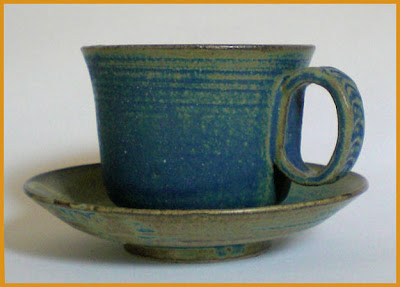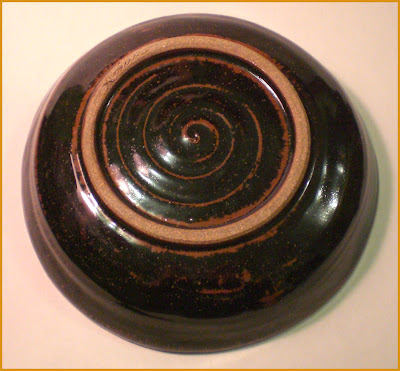
Tuesday, August 31, 2010
Monday, August 30, 2010
Cups from the weekend
Friday, August 27, 2010
"Water that birds don´t drink"
 Electric wheel, electric kiln, 1250ºC- Some results from my glazes research.
Electric wheel, electric kiln, 1250ºC- Some results from my glazes research.Torno eletrico, forno elétrico, 1250ºC- Alguns resultados de minha pesquisa de vidrados.
This cup set was made to a traditional brazilian drink, the cachaça. Cachaça first gained popularity during Brazil’s colonial period. And this spirit has become a favorite in Brazil and internationally.
Estes copinhos foram feitos para uma bebida tradicionalmente brasileira, a cachaça. A cachaça ganhou popularidade durante o período colonial brasileiro. E estaa bebida tornou-se uma favorita tanto no Brasil quanto no exterior.
 Carvalheira is a traditional cachaça from Recife, knowed as a black cachaça. In the bottle
Carvalheira is a traditional cachaça from Recife, knowed as a black cachaça. In the bottlewe can see the photo of the first generation of the Carvalheira family in Pernambuco state in 1893.
A Carvalheira é uma tradicional cachaça de Recife, conhecida como cachaça negra. No rótulo
podemos ver a foto da primeira geração da família Carvalheira em Pernambuco no ano de 1893.
Cachaça is a distilled made from sugarcane in a different way from rum. Their only
similarity is that they both originate from sugarcane.
Cachaça is the main ingredient of the most famous brazilian drink: Caipirinha. The cocktail combines crushed limes, sugar, ice, and cachaça to produce a sweet and zesty flavor packed with "right" alcoholic intensity.
Cachaça é um destilado feito a partir da cana de açucar, mas muito diferente do rum. A única similaridade é que ambas são feitas de cana de açucar. A cachaça é o ingrediente principal da mais famosa bebida brasileira: A Caipirinha. O drink combina limão espremido, açucar, gelo e cachaça, produzindo um sabor doce e ao mesmo tempo azedo,
com a dose "certa" de alcool.
No one knows for sure who began cachaça production, but everyone agrees that it began in Pernambuco state, between 1530 and 1550. Around this time, sugarcane had been introduced to Brazil as a cash crop by their colonial motherland Portugal. Slaves, who planted and harvested the sugarcane, were given leftover cane juice from the milling process and let it ferment to produce an alcoholic beverage.The cachaça can be aged using a variety of woods for the barrels, including Brazilian woods such as imburana, cedar, freijó, and jequitibá and American and European oak, which give the liquor a smoother, rounder taste.
The Brazilian Cachaças also receive endless brands, sometimes funny.
And I even found one that have my name! Despite the brands, Brazilians also order Cachaça by nicknames. And if someday a Brazilian invites you to drink a "water that birds don´t drink", relax, he or she is only inviting you to drink a shot of cachaça.
Cheers!
For more references see:
http://www.cachacastore.com/sistema/custom.asp?IDLoja=4603&arq=cachaca.html&1ST=1&Y=2854438707957
Ninguem sabe ao certo como surgiu a cachaça. Mas todos concordam que sua produção começou em Pernambuco entre 1530 e 1550. Nesta época, a cana de açucar foi introduzida no Brasil para cultivo com base econômica pelos colonizadores Portugueses. Os escravos, que plantavam e colhiam a cana de açucar, recebiam suco de cana (garapa) que deixavam fermentar, produzindo assim uma bebida alcoólica. As cachaças podem ser envelhecidas em madeiras brasileiras, como imburana, cedro, feijó, jequitibá e até mesmo carvalho europeu ou americano que dão á elas um sabor suave e delicado.
The Brazilian Cachaças also receive endless brands, sometimes funny.
And I even found one that have my name! Despite the brands, Brazilians also order Cachaça by nicknames. And if someday a Brazilian invites you to drink a "water that birds don´t drink", relax, he or she is only inviting you to drink a shot of cachaça.
Cheers!
For more references see:
http://www.cachacastore.com/sistema/custom.asp?IDLoja=4603&arq=cachaca.html&1ST=1&Y=2854438707957
Ninguem sabe ao certo como surgiu a cachaça. Mas todos concordam que sua produção começou em Pernambuco entre 1530 e 1550. Nesta época, a cana de açucar foi introduzida no Brasil para cultivo com base econômica pelos colonizadores Portugueses. Os escravos, que plantavam e colhiam a cana de açucar, recebiam suco de cana (garapa) que deixavam fermentar, produzindo assim uma bebida alcoólica. As cachaças podem ser envelhecidas em madeiras brasileiras, como imburana, cedro, feijó, jequitibá e até mesmo carvalho europeu ou americano que dão á elas um sabor suave e delicado.
As Cachaças Brasileiras tem os rótulos mais variados e às vezes engraçados. E eu até achei uma com o meu nome! Além dos rótulos, os brasileiros chamam a cachaça por vários apelidos. E se um dia um brasileiro chamar você para tomar "água que passarinho não bebe", relaxe, ele ou ela, esta lhe convidado para tomar uma dose de cachaça.
Saúde!
Saúde!
Thursday, August 26, 2010
Monday, August 23, 2010
Iron Glaze
Marcadores:
Eletric Kiln,
Glazes,
To office
Lavender set
Marcadores:
Bowl,
Eletric Kiln,
Plates
Sunday, August 22, 2010
Pencil and Card Holder
Friday, August 20, 2010
Sculptures by birds

There are a lot of avocado trees at my yard.
When walking around, I always find this delicated sculptures made by birds.
They are all different and I love this texture. Inspiring...
Details around like this, makes me happy!
Nice weekend!
Aqui no quintal há vários abacateiros.
Quando passeio por ai sempre acho estas delicadas esculturas feitas pelos passáros.
Todas são diferentes e eu adoro essa textura. Inspiradoras...
Mais uma da série: "Detalhes ao redor" que me deixam feliz!
Bom final de semana!
When walking around, I always find this delicated sculptures made by birds.
They are all different and I love this texture. Inspiring...
Details around like this, makes me happy!
Nice weekend!
Aqui no quintal há vários abacateiros.
Quando passeio por ai sempre acho estas delicadas esculturas feitas pelos passáros.
Todas são diferentes e eu adoro essa textura. Inspiradoras...
Mais uma da série: "Detalhes ao redor" que me deixam feliz!
Bom final de semana!
Sunday, August 15, 2010
Violets
Saturday, August 14, 2010
Monday, August 9, 2010
The first Tuca´s yunonis
Sunshine light
Thursday, August 5, 2010
Yin & Yang

 Eletric Kiln, 1260ºC.
Eletric Kiln, 1260ºC.The balance between these two glazes, specially the fusion,
and the cobalt oxide details, pleases me. I intend to continue to experiment it.
But, I would love to hear what you think about it.
Since the first test of this two glazes, I have this passage of Tao Te Ching on my mind...
"The Tao begot one.
One begot two.
Two begot three.
And three begot the ten thousand things.
The ten thousand things carry yin and embrace yang.
They achieve harmony by combining these forces."
O equilíbrio entre esses dois esmaltes, especialmente a fusão deles,
e o detalhe em óxido de cobalto me agradam. Acho que vou continua a explora-los.
Mas, eu gostaria de ouvir a opinião de vocês.
Desde o primeiro teste destes dois esmaltes,
eu tenho esta passagem do Tao Te Ching na cabeça...
O Caminho gera o um
O um gera o dois
O dois gera o três
O três gera os dez mil seres
Os dez mil seres se cobrem com o obscuro e abraçam o claro
E se harmonizam através do esplêndido sopro
Wednesday, August 4, 2010
Open Space
I would like to share with you photos
of some pieces that were made by special fellows:
 Estela Miyauchi - Gas Kiln - 1300ºC
Estela Miyauchi - Gas Kiln - 1300ºC
of some pieces that were made by special fellows:
 Estela Miyauchi - Gas Kiln - 1300ºC
Estela Miyauchi - Gas Kiln - 1300ºCMonday, August 2, 2010
Finished Mugs
Sixth edition of "O prato é seu!"
and still coordinates, the event known as " O Prato é seu!" (The plate is yours).
Lucia and another dear potter, Louise Deroualle (responsible for producing the event), always encourage the participation of fellow potters. In its sixth edition, the event is in support of the entity Estrela Nova, a Community Movement in Campo Limpo, district of São Paulo city.
I was pleased to be able to donate some of my square plates.
I would like to thank the opportunity and to all who contribute to initiatives like this.
Congratulations to all sponsors.
I must not forget to mention and hightlight the participation of Mr. Shugo Izumi,
who between 2007 and 2008, was recognized by the Japanese government as one
of the world's best ceramists, as the ABMT site says. He lives and produces
in Atibaia city - São Paulo.
Lucia and another dear potter, Louise Deroualle (responsible for producing the event), always encourage the participation of fellow potters. In its sixth edition, the event is in support of the entity Estrela Nova, a Community Movement in Campo Limpo, district of São Paulo city.
I was pleased to be able to donate some of my square plates.
I would like to thank the opportunity and to all who contribute to initiatives like this.
Congratulations to all sponsors.
I must not forget to mention and hightlight the participation of Mr. Shugo Izumi,
who between 2007 and 2008, was recognized by the Japanese government as one
of the world's best ceramists, as the ABMT site says. He lives and produces
in Atibaia city - São Paulo.
Bedtime tea
 Handbuilt, 1300ºC, gas kiln.
Handbuilt, 1300ºC, gas kiln.We had a full family weekend,
and this tea-pot had the opportunity to "listen" again some more
stories from the older relatives, on my kitchen table.
Things like this make it so special to me.
I did this piece with the orientation of my dear master Estela Miyauchi.
It was my first handbuit tea-pot made 5 years ago, and it is still in use.
Subscribe to:
Comments (Atom)






























